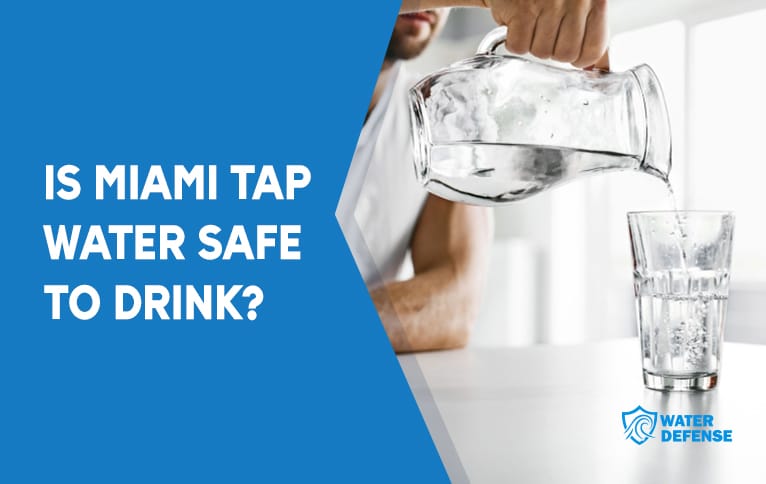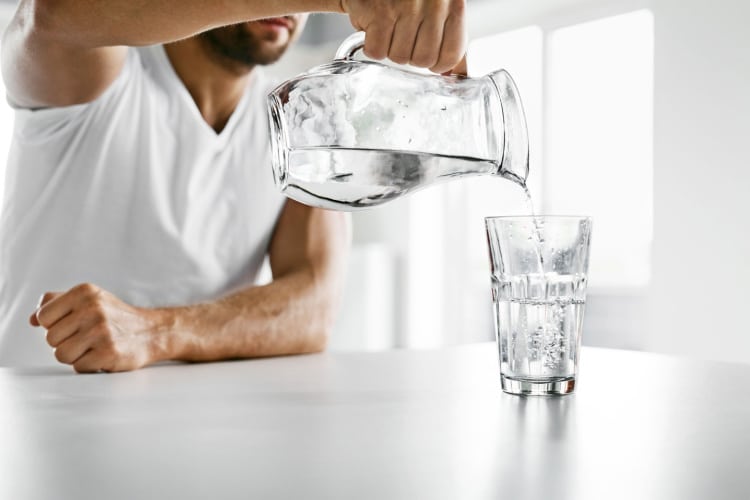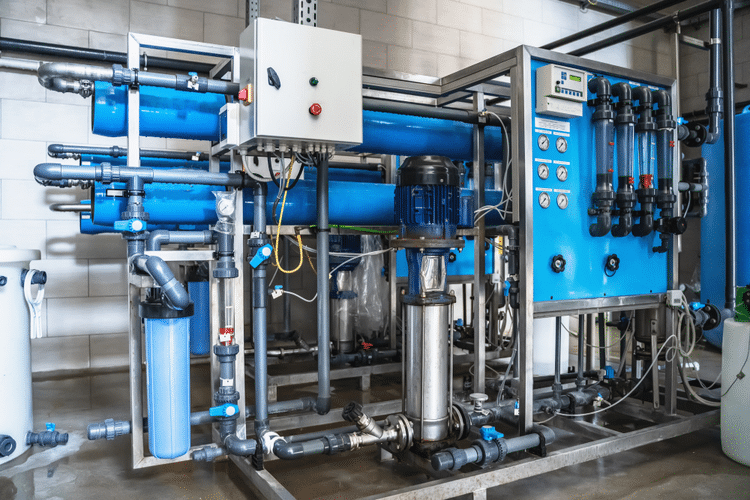Miami is the most populated and popular city in the state of Florida, one of the states with the worst drinking water quality in the US. The Miami Dade Water and Sewer Authority serves water to more than two million people, and the city’s a tourist hotspot, adding to the importance of the safety of its water.
However, despite the city’s compliance with the National Primary Drinking Water Regulations (NPDWRs) set by the Environmental Protection Agency (EPA), the tap water in Miami isn’t completely safe. The latest water quality report by the Miami Dade Water and Sewer Authority shows that some hazardous contaminants (heavy metals, disinfection byproducts, and perfluorinated substances) are present at excessive levels.

Below, we’re going to list these contaminants, explain how they end up in Miami tap water, what risks they carry, and how you can eliminate the threat they present. Later in the article, we will share information regarding the water hardness in Miami, where Miami’s tap water comes from, and how the municipal authority treats it.
Miami Water Quality Report: What’s in the Water?

The latest water quality report shows that Miami’s tap water has lead, copper, disinfection by-products such as total trihalomethanes and haloacetic acids, and perfluorinated substances (PFAS, PFOS, PFOA, etc.).
The EPA has two regulatory numbers that are important when discussing contaminants regulated under the NPDWRs: action limit and public health goal. While the former refers to the limit of a particular contaminant after which the agency needs to take action, the latter refers to the actual safety limit of a certain impurity. So, the action limit is often higher than the public health goal.
All the contaminants we mentioned above have tested above the action limit in at least five of the water samples taken for the water quality report.
Now, let’s learn exactly how much.
Lead and Copper
Miami Dade is responsible for providing water for four distinct territories — Main System, South Dade, North Miami Beach, and Redavo. All these water systems have at least one building under their jurisdiction where the samples tested above the EPA action limit of 15 parts per billion (ppb). The excess percentages are 1%, 2%, 6%, and 2.3%, respectively.
The buildings that weren’t above the maximum allowable lead content aren’t exactly in the clear either. The EPA sets its public health goal for lead at zero since this heavy metal isn’t safe, even in trace amounts. The Main System has 3.6 ppb, South Dade has 2.2 ppb, North Miami Beach has 3.4 ppb, and Redavo has 1.2 ppb on average, which isn’t great.
The copper situation is a bit better. No sample from the Main System and North Miami Beach exceeded the EPA action limit and public health goal of 1,3 parts per million (ppm). But samples from South Dade and Redavo did — 7% of the samples from South Dade show copper content higher than the action limit, while in Redavo, that number is 16%.
The average presence of copper in the Main System is 0.06 ppm, and North Miami Beach only has 0.07 ppm. However, in South Dade, the copper average is 1.1 ppm, while the average copper level in Redavo is above the action limit: 1.5 ppm.
Lead and copper have been and still are a serious problem in America’s tap water because these heavy metals were heavily used in plumbing and piping systems up to the 1980s. Once lead and copper start corroding, they dissolve into the water in increasing amounts.
The EPA eventually took action against this problem in 1991 and introduced a lead and copper rule, forbidding the further utilization of these health hazards in piping components such as fixtures, solders, and pipes. Yet, not everybody has the means to replace their house’s whole piping system, so lead and copper continue to be a problem for Miami’s water supply.
As per the NPDWRs, which we referenced at the beginning of this article, both heavy metals have serious health repercussions. Lead is linked with arrested development in children, and cardiovascular and kidney issues in adults, while copper leads to gastrointestinal distress with short-term exposure and kidney and liver problems in the long-term.
If you’re in an area where lead and copper presence is above legal limits and public health goals, we first recommend you conduct a water test. You can do it by purchasing a water test kit, which is faster, or sending a water sample to an EPA-certified laboratory, which is more reliable.
Should your sample test positive for lead or copper, you need to take action. Our guide on the best lead water filtration units offers both high-end and budget-friendly options effective against copper.
Disinfection Byproducts
Municipalities disinfect public water with chlorine and chloramines before distributing it to the city’s water lines. These chemicals destroy bacteria and thwart infestation in municipal piping systems, but they also create potentially hazardous byproducts such as bromate, total trihalomethanes (TTHMs), and haloacetic acids (HAA5).
Among these disinfection byproducts, the presence of TTHMs and HAA5, in particular, is at alarming levels in the Miami tap water.
The EPA action limit for TTHMs is 80 ppb, and 60 ppb for HAA5. However, the public health goal for many trihalomethane and haloacetic compounds is zero since these chemicals have been linked with increased cancer risk.
In various samples from the South Dade Water Supply System, the TTHMs test equal to the action limit: 80 ppb.
The other Miami supply systems perform better: the Main System has a TTHMs range of 7 ppb to 71 ppb, while the highest TTHMs levels in North Miami Beach and Redavo are 28 ppb and 50 ppb, respectively. Still, all these numbers are well above the public safety goal.
Regarding HAA5, the Main System emerges as the most problematic water supply in Miami. The system has an average of 46 ppb of HAA5, while some areas that get their water from this particular system get 67 ppb of HAA5 from their water supply. HAA5 has a 3-19 pbb presence in the South Dade supply, 8-34 ppb in North Miami Beach, and 12-16 ppb in Redavo.
Since every water supply in the Miami metro area has disinfection byproduct levels exceeding EPA health goals, we recommend that you install a water filter that is effective against these chemical compounds.
Perfluorinated Substances (PFAS)
PFAS is an umbrella term that covers a group of newly emerging chemical compounds (like perfluorooctane sulfonate, also known as PFOS, and perfluorooctanoic acid, known as PFOA) that the EPA doesn’t yet regulate. These compounds have been widely used in many industries over the last few decades, from fire fighting to food packaging and water-resistant products, the effects of which we’re still feeling today.
What’s worse is they have a very slow degradation rate in nature. So, now they’re everywhere: in our soil, our urine, our oceans, in fish and animals, and ultimately, in the water supply, be it underground aquifers or surface sources like rivers and lakes.
Although the scientific research on PFAS is still in the preliminary stages, according to the EPA (by August 2023), you can find an ample number of studies that connect these substances to adverse health effects such as preeclampsia, cholesterol issues, and elevated risk of cancer.
Since the EPA doesn’t consider these studies conclusive, it hasn’t set an action limit or public health goal for PFAS. But, on March 14, 2023, the Biden-Harris Administration proposed an action limit of 4 parts per trillion (ppt).
That is bad news for Miami because the city’s Main System has perfluorooctane sulfonate in a range of 10 ppt and 36 ppt and perfluorooctanoic acid in 4 ppt and 12 ppt. Even at the lowest presence, the PFAS content of Miami water is above the proposed action limit.
While the Miami Dade Water and Sewer Authority doesn’t provide numbers for its North Miami Beach system, the case is no better in the other two systems:
- Perfluorooctane sulfonate (PFOS): South Dade has 17 ppt to 33 ppt, and Redavo has an average of 17 ppt.
- Perfluorooctanoic acid (PFOA): South Dade has 1 ppt to 9 ppt, and Redave has an average of 1 ppt.
Considering PFAS levels are high in almost every Miami district, it’s best to invest in a water filtration item for PFAS removal if you live in Miami.
Miami Tap Water Contaminant Chart
In this section, we present you with a contaminant chart that shows the city water contamination levels in the city’s four different water supplies. The chart also allows you to compare the contamination levels with the EPA action limits and public health goals.
We had to abbreviate the following for space-saving purposes:
- MS: Main System
- SD: South Dade
- NMB: North Miami Beach
- AL: Action Limit
- PHG: Public Health Goal
| Contaminants | MS levels | SD levels | NMB levels | Redavo levels | EPA AL | EPA PHG |
| Lead (avg.) | 3.6 ppb | 2.2 ppb | 3.2 ppb | 1.2 ppb | 15 ppb | Zero |
| Copper (avg.) | 0.06 ppm | 1.1 ppm | 0.07 ppm | 1.5 ppm | 1.3 ppm | 1.3 ppm |
| TTHMs | 7-71 ppb | 9-80 ppb | 7-28 ppb | 38-50 ppb | 80 ppb | Zero |
| HAA5 | 14-67 ppb | 3-19 ppb | 8-34 ppb | 12-16 ppb | 60 ppb | Zero |
| PFOS | 10-36 ppt | 17-33 ppt | N/A | 17 ppt (avg.) | 4 ppt (proposed) | N/A |
| PFOA | 4-12 ppt | 1-9 ppt | N/A | 1 ppt. (avg.) | 4 ppt (proposed) | N/A |
Water Hardness
South Florida, where Miami is, has hard water overall because the aquifers under the southern parts of the state that provide water to its citizens are rich in calcium and magnesium. The levels of hard water minerals in this region range between 200 ppm and 400 ppm, which is classified as extremely hard by the United States Geological Survey (USGS).
That being said, we don’t have the numbers for Miami tap water specifically. The Miami Dade Water and Sewer Authority doesn’t provide information regarding water hardness in Miami. We know that they try to soften the water before distributing it to the city’s water lines, but we don’t know how softened the end product actually is.
Other reliable sources, like the EPA or the Environmental Work Group (EWG), don’t give exact reports either. However, the studies conducted by the USGS and the University of Florida put Miami in the extremely hard water zone.
Hard water doesn’t have any adverse effects on health. Rather, calcium and magnesium are essential minerals that maintain and regulate many vital functions, including our nerves, muscles, bones, enzymes, hormones, and blood.
Yet, the presence of these minerals in cleaning, bath, dishwashing, or laundry water isn’t ideal. They tend to build up in pipes and appliances, lead to clogs and breaks, stain surfaces, kitchenware, and laundry, and cause dry skin and dull hair.
If you want to eliminate these issues, you can install a water softener. Our guide can help you find your way through the state-of-the-art traditional water softeners on the market. You can also check out our guides on the best saltless water conditioners and magnetic water descalers, which are eco-friendly alternatives to traditional salt-based units.
Where Does Miami’s Tap Water Come From?
Miami relies on groundwater drawn with the help of huge wells. The majority of Miami’s groundwater comes from the Biscayne Aquifer, which sits right below the city. A minority of wells draw water from the Floridan Aquifer that sits below the whole state.
The aquifers in Florida are mostly surrounded by limestone layers and other similar porous rock formations that have natural water filtration properties. However, the water in the state is still unsafe. The Miami Dade water quality report we shared above establishes that there are 91 different contamination sources in these aquifers in varying degrees of susceptibility.
Additionally, the residents of Miami, like all Floridians, are now face to face with a water shortage challenge. As one of the most tourist-popular places in the country, the water demand in Miami is constantly increasing, while the underground water sources are on a withdrawing trend.
The federal authorities are in search of alternative water sources, like the desalination plant in Tampa Bay that turns seawater into safe tap water. But the effects of these attempts on Miami’s water plans are yet to be seen.
How Is Tap Water Treated in Miami?

The tap water treatment in Miami is a bit different than the regular tap water treatment (coagulation, flocculation, sedimentation, filtration, and disinfection) typically used in other U.S. states.
Here’s an overview of the water treatment in Miami’s Main System, South Dade, North Miami Beach, and Redavo supply systems.
- Collection: Huge well pumps draw water from various underground aquifers. Then, the water from different locations is transferred to water treatment facilities.
- Softening: The treatment facility introduces lime into the water in a large tank. Once hard water minerals come into contact with lime, they start to stick together, forming clumps and sinking to the bottom of the tank. The mineral clump at the bottom is called lime sludge.
- Disinfection: Miami’s disinfection process is two-stage. In the first stage, known as primary disinfection, the facility pumps chlorine into the water in order to destroy pathogenic microorganisms such as bacteria and protozoa. In the secondary disinfection, ammonia is introduced to the chlorinated water, a reaction that produces chloramines. Chloramines ensure the water lines are safe from bacterial infestation.
- Filtration: Unlike most other municipalities that utilize reverse osmosis or microfiltration in this stage, the Miami Dade Water and Sewer Authority employs dual sand/anthracite filter media. These media remove the remaining particles from the water without affecting the chlorine and chloramine levels.
- Corrosion control: As established earlier, the pipe components in older piping systems in Miami tend to corrode a lot and dissolve lead and copper into the water. To prevent that, the facility introduces a phosphorus compound into the water.
- Fluoridation: Almost all water authorities in the United States pump fluoride into the water to promote teeth health, and that’s also the case in Miami. The fluoride levels in the water rarely surpass the EPA action limit and public health goal of 4 ppm. In Miami, the fluoride presence in water ranges between 0.1 ppm and 0.9 ppm. However, if you want to have completely fluoride-free drinking water, you can check out our guide on the best fluoride filters.
Additionally, there are four other water treatment plants in Miami: the Alexander Orr, Jr. Water Treatment Plant, the Hielah Water Treatment Plant, the John Preston Water Treatment Plant, and the Hielah Reverse Osmosis Plant Supply System.
The first one operates similarly to the main systems. In the Hileah and John Preston plants, the softening process is a bit more rigorous due to the higher total dissolved solids count of the groundwater in the area. In addition, these plants employ a water treatment method called air-stripping to eviscerate volatile organic compounds.
The Hielah Reverse Osmosis Plant, evidently, makes use of reverse osmosis. However, since reverse osmosis produces acidic water, the plant engages in pH adjustment and degasification (removal of gasses such as dissolved oxygen and carbon dioxide) in later stages.
Conclusion: Does Miami Have the Cleanest Water?
Miami doesn’t have the cleanest water.
Water samples indicate that there’s copper and lead presence higher than the EPA action limit. Lead is a serious problem in all four Miami water supplies as it tests above the limit in at least 1% of water samples. Copper is a serious problem in the South Dade and Redavo districts.
When it comes to disinfection byproducts, the situation is no better. There are buildings in South Dade where the tap water’s TTHMs count is equal to the EPA action limit. In the Main System, the maximum HAA5 presence is 67 ppb, whereas the EPA action limit for this disinfection byproduct is 60 ppb.
Lastly, the PFAS levels in Miami’s tap water are quite concerning. Both PFOS and PFOA are above the proposed action limit of 4 ppt in most districts. Only the PFOA levels in the Redavo water supply (1 ppt) get a passing grade.
So, if you’re a resident of Miami, it’s wise to invest in a water filtration unit capable of eliminating heavy metals such as lead and copper, disinfection byproducts, and PFAS.